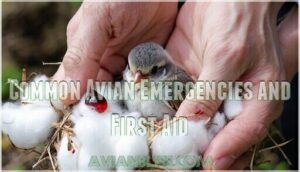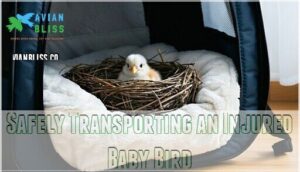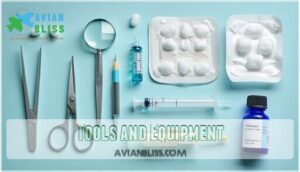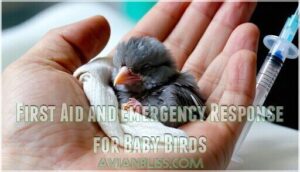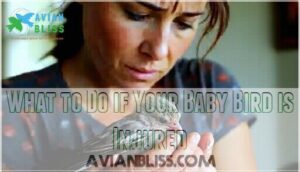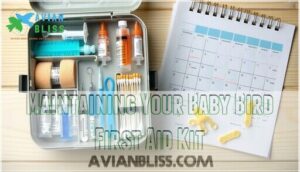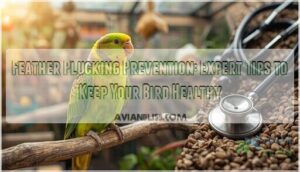This site is supported by our readers. We may earn a commission, at no cost to you, if you purchase through links.
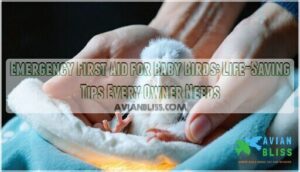
Start by moving your feathered friend to a quiet, warm space away from other pets.
For bleeding, apply gentle pressure with a clean cloth.
If you spot a broken blood feather, don’t panic – it’s like a bloody nose that needs quick attention.
Keep your bird warm using a heating pad on low or towels.
Never give water to an unconscious bird, but you can offer small sips to alert ones.
Emergency first aid for baby birds often means buying precious time until you reach your vet.
Sometimes the simplest techniques make the biggest difference.
Table Of Contents
- Key Takeaways
- Preparing for Baby Bird Emergencies
- Emergency First Aid for Baby Birds
- Common Avian Emergencies and First Aid
- Stabilizing a Sick Baby Bird
- Safely Transporting an Injured Baby Bird
- Essential Items for a Baby Bird First Aid Kit
- First Aid and Emergency Response for Baby Birds
- What to Do if Your Baby Bird is Injured
- Preventing Bird Accidents and Mishaps
- Maintaining Your Baby Bird First Aid Kit
- Frequently Asked Questions (FAQs)
- What should I do if my bird is sick?
- How do you feed a sick bird?
- What should you do if a bird is attacked?
- How do you treat a wound on a bird?
- What should I do if my bird has a bacterial infection?
- How can I help an injured baby bird?
- Should I give an injured baby bird water?
- What is the best pain relief for birds?
- What to do with a bird that can’t fly?
- What are signs a baby bird needs CPR?
- Conclusion
Key Takeaways
- Stay calm and act fast – When your baby bird faces an emergency, move it to a quiet, warm space away from other pets, then assess the situation without panicking, since your quick thinking can mean the difference between life and death.
- Control bleeding immediately – Apply gentle pressure with a clean cloth for wounds, use cornstarch or styptic powder for bleeding beaks or nails, and completely remove broken blood feathers to stop hemorrhaging.
- Maintain warmth and hydration – Keep your injured bird at 80-85°F using heating pads or towels, offer small sips of water to alert birds only, and never give fluids to unconscious birds.
- Prepare before emergencies strike – Stock a first aid kit with saline solution, antiseptic, aloe vera, cotton swabs, and heating sources, while establishing a relationship with an avian veterinarian who offers emergency services.
Preparing for Baby Bird Emergencies
Being prepared for baby bird emergencies can make the difference between panic and confident action when your feathered friend needs help most.
You’ll want to establish key relationships and gather essential supplies before trouble strikes, because baby birds don’t wait for convenient timing when they decide to get into mischief.
Establishing a Relationship With an Avian Veterinarian
Before your baby bird faces an emergency, finding the right avian veterinarian becomes your most important task.
Think of it as assembling your bird’s personal medical team. You’ll want someone who truly understands feathered patients, not just dogs and cats.
Here’s your action plan for building that vital relationship:
- Research vet qualifications – Look for board-certified avian specialists or veterinarians with extensive bird experience and specialized care training.
- Verify emergency availability – Confirm they offer after-hours services or have partnerships with wildlife rehabilitators for urgent situations.
- Schedule regular checkups – Establish trust building through routine visits, allowing your local avian veterinarian to understand your bird’s normal behavior and health baseline.
Recognizing and Treating Simple Problems
Before emergencies strike, learning basic wound care and early symptom recognition saves lives.
You’ll spot common ailments like minor cuts, broken feathers, and dehydration quickly with practice.
Minor cuts
Broken feathers
Egg-binding
Master these home remedies for confident baby bird rescue.
Observing Bird Behavior for Early Detection
Your feathered detective work starts with daily observation of normal patterns. Watch for subtle signs like changes in appetite, posture, or vocalizations that signal trouble brewing.
Early intervention depends on spotting behavioral changes before they escalate. Different species differences mean unique warning signals.
Key signs to monitor:
- Fluffed feathers when it’s not cold
- Sitting quietly at the cage bottom
- Changes in droppings color or consistency
- Less chirping or unusual silence
Emergency First Aid for Baby Birds
When your feathered friend faces trouble, quick action saves lives. Baby bird feeding becomes critical during emergencies, but first things first – assess the situation calmly.
Emergency moments test your bird parent skills—stay calm, act fast, and trust your instincts to save tiny lives.
Orphaned nestlings need immediate warmth and safety. Place the bird in a small, ventilated box lined with soft cloth. Keep it at room temperature, away from drafts and pets. Don’t worry about imprinting concerns right now – survival comes first.
Check for obvious injuries like bleeding or broken limbs. Stop bleeding with cornstarch or styptic powder. Avoid giving food or water until you’ve contacted a wildlife rehabilitator – dehydrated birds can’t process nutrition properly.
Here’s your emergency action plan:
- Secure the bird in a warm, quiet box
- Control bleeding with cornstarch or pressure
- Contact professionals immediately for guidance
- Monitor closely for signs of distress.
Remember, zoonotic diseases can spread from birds to humans, so wash your hands thoroughly. Your quick thinking makes all the difference in avian emergency situations.
Common Avian Emergencies and First Aid
When your baby bird faces an emergency, knowing how to handle bleeding beaks, broken feathers, or heat stroke can mean the difference between life and death.
You’ll learn simple first aid techniques that work fast, because panicking birds don’t wait for you to Google solutions.
Bleeding Beak or Nail
When your bird’s beak or nail starts bleeding, don’t panic.
Pressure application is your first move – gently restrain your bird and apply styptic powder or cornstarch directly to the bleeding area.
For bleeding control, hold firm pressure for several minutes.
You can find bird styptic powder online.
This bird first aid technique stops most bird hemorrhage control situations quickly, preventing serious blood loss during this avian emergency.
Broken Blood Feather
A broken blood feather creates serious bleeding since feather anatomy includes active blood vessels.
You’ll see blood streaming from the feather shaft – this requires immediate bleeding control.
Wrap your bird in a towel, then firmly grasp and pull the entire feather out. This bird hemorrhage control method stops bleeding instantly.
Proper technique is important when performing blood feather extraction. Pack the area with cornstarch if needed for complete feather care.
Skin Wound
A small cut on your feathered friend needs prompt attention to prevent complications.
Start with gentle wound cleaning using saline solution—it’s like giving your bird a mini spa treatment. Apply aloe vera sparingly for natural healing benefits.
Watch for infection signs like redness, swelling, or discharge. Proper bandaging technique protects the area while promoting scar prevention.
Clean environments reduce future bird injuries substantially. You can find specialized avian products to aid in wound recovery.
Animal Bites or Scratches
Cat and dog attacks pose serious infection risk for baby birds due to bacteria in saliva.
Quick wound cleaning saves lives—here’s your action plan:
- Rinse wounds thoroughly with lukewarm water for 5-10 minutes
- Apply antiseptic like diluted hydrogen peroxide to disinfected areas
- Control bleeding with direct pressure using clean gauze
- Seek veterinary care immediately for antibiotic use and pain management
Proper bite wounds treatment prevents scarring prevention complications.
Heat Stroke
While scratches and bites need quick attention, heat stroke can kill your baby bird faster than you’d think.
Recognizing symptoms like panting and wing-spreading saves lives.
Your cooling methods should include tepid water misting—never ice-cold shocks.
Hydration strategies and shade provision are essential for injured bird care.
These preventative measures beat emergency fledgling care every time.
Stabilizing a Sick Baby Bird
When your baby bird looks unwell, you’ll need to act fast to create the right conditions for recovery.
Think of yourself as a bird hotel manager – your feathered guest needs warmth, gentle encouragement to eat and drink, and a peaceful room away from household chaos.
Keeping The Bird Warm
When your baby bird shows illness signs, think of warmth as their security blanket.
Hypothermia in birds can turn critical fast, so safe heating becomes your first priority.
- Set temperature between 80-85°F using bird heating methods like ceramic heat lamps
- Monitor warmth indicators – check frequently to prevent overheating
- Use insulation methods with soft towels while maintaining airflow
- Maintain bird warmth during transport with portable heating pads
Encouraging The Bird to Eat and Drink
After establishing warmth, Syringe Feeding becomes your next lifeline for baby birds struggling to eat. Think of yourself as a patient caregiver coaxing a reluctant diner.
| Method | Approach |
|---|---|
| Appetite Stimulants | Offer favorite treats like millet |
| Rehydration Methods | Use droppers with clean water |
| Dietary Needs | Provide high-protein baby food |
| Bird Nourishment | Try soft, easily digestible options |
| Gradual Introduction | Mix familiar foods with new ones |
Bird Hydration takes priority—dehydrated birds can’t process food properly. Bird Rehydration solutions work wonders here.
Providing a Quiet Resting Environment
Once your baby bird’s eating, focus on creating the perfect recovery space. Think of it as their personal spa retreat where healing happens best.
Set up your bird’s quiet sanctuary:
- Dim lighting – bright lights stress sick baby birds
- Sound dampening materials to minimize stress from household noise
- Safe enclosure with proper baby bird warmth and reduce stimulation
Your bird resting environment directly impacts recovery speed.
Safely Transporting an Injured Baby Bird
Getting your injured baby bird to the vet safely can feel like carrying a tiny, fragile egg across town.
You’ll need a secure carrier with proper ventilation and warmth to keep your feathered friend comfortable during what might be the most important car ride of its little life, ensuring a safe and warm environment.
Utilizing a Secure Carrier
Once your baby bird’s stable, choosing the right bird carrier becomes your next priority.
Carrier size matters—pick one that’s snug but not cramped. Your feathered patient needs room to stand without excessive space that could cause injury during transport.
Focus on sturdy carrier material with proper ventilation needs to prevent overheating. Good airflow reduces stress while ensuring bird transport safety to the vet.
Keeping The Bird Warm During Transport
Warmth becomes your top priority when transporting an injured baby bird. Safe heat sources like heating pads or hand warmers wrapped in towels work perfectly.
Think of creating a mobile nest that mimics mama bird’s care. Carrier insulation using blankets helps maintain steady temperatures during transport duration.
Monitor your feathered patient – shivering means they’re too cold, panting suggests overheating. Proper temperature monitoring and stress reduction through consistent warmth can mean the difference between life and death for orphaned bird help situations.
Ensuring Proper Ventilation
Proper airflow keeps your injured baby bird breathing easy during transport—think of it as giving them their own personal air conditioning system.
Poor box ventilation can lead to bird respiratory distress faster than you’d expect.
Here’s how to avoid turning your rescue mission into a suffocation scenario:
- Create multiple small holes in the carrier for steady airflow importance without creating drafts
- Monitor respiration by watching for open-beak breathing or tail bobbing
- Control humidity using slightly damp cloth if air feels too dry
Remember, orphaned bird help starts with emergency first aid basics.
Essential Items for a Baby Bird First Aid Kit
You’ll want to keep a well-stocked first aid kit ready before your feathered friend needs help, because baby bird emergencies don’t wait for convenient timing.
Having the right supplies within arm’s reach can mean the difference between a quick recovery and a frantic scramble to find what you need when every second counts.
Saline Solution and Antiseptic Liquid
Every bird owner needs these cleaning essentials in their first aid arsenal.
Saline solution and antiseptic liquid serve as your frontline defense against infections when accidents happen.
- Saline preparation: Mix one teaspoon salt with one cup warm water for gentle wound cleaning
- Antiseptic types: Choose bird-safe options like diluted betadine or hydrogen peroxide
- Application methods: Use cotton swabs for precise cleaning around delicate areas
- Safe dilution: Always dilute antiseptics properly to prevent skin irritation
Aloe Vera and Cotton Swabs
Beyond basic cleaning supplies, you’ll want gentle healing agents in your bird first aid arsenal. Aloe vera works like nature’s own band-aid for minor scratches and irritated skin. Choose pure, unflavored gel without additives—baby birds don’t need extra chemicals.
Cotton swabs become your precision tools for wound cleaning and feather care. Their soft tips let you apply treatments exactly where needed without overwhelming tiny patients.
Master your swab technique by dabbing gently rather than rubbing. For aloe application, use just a thin layer—less is more with baby birds. These safe usage practices guarantee your emergency first aid efforts help rather than harm.
Tools and Equipment
Three essential tools can mean the difference between panic and preparedness when your baby bird needs help.
Your first aid kit should include precision instruments like tweezers for removing debris, small scissors for trimming damaged feathers, and feeding syringes for administering fluids.
A magnifying glass helps examine tiny wounds closely, while hemostats control bleeding from broken blood feathers.
Essential immobilization tools for your bird first aid kit:
- Cotton swabs and sterile gauze for gentle wound cleaning
- Heat sources like electric heating pads for maintaining warmth
- Cleaning supplies including saline solution and antiseptic liquid
First Aid and Emergency Response for Baby Birds
When your baby bird faces a real emergency, you’ll need to act fast and stay calm like a tiny feathered paramedic.
The three key steps that can save your bird’s life are getting them warm and hydrated, stopping any bleeding, and managing their pain until you reach professional help.
Rehydration and Warmth
With your first aid kit ready, dehydrated baby birds need immediate attention.
You’ll spot bird dehydration through sunken eyes and lethargy. Use bird rehydration techniques with ricelyte or pedialyte for fluid administration. Safe heating keeps them cozy while providing nutritional support in a quiet environment helps recovery.
| Rehydration Method | Temperature Guide |
|---|---|
| Pedialyte with dropper | 85-90°F heating pad |
| Ricelyte solution | Warm towel wrapping |
| Sweetened water | Heat lamp monitoring |
| Commercial electrolytes | Room temperature check |
| Veterinary fluids | Digital thermometer |
Monitor progress closely—they’re counting on you.
Immobilization and Control of Hemorrhage
Once your bird is stable, fracture immobilization becomes your next priority.
Gently wrap broken wings or legs using soft gauze and tape—think bird burrito, not mummy!
For feather bleeding, pull out damaged blood feathers completely to stop the flow.
Apply cornstarch or styptic powder to bleeding nails or beaks.
Safe handling during bleeding control prevents further trauma while you master these bird hemorrhage techniques.
Pain Relief and Hospitalization
After stopping bleeding and immobilizing injuries, your baby bird may need pain medication and veterinary assessment. Don’t let your feathered friend suffer in silence.
Here’s what to watch for regarding hospitalization needs:
- Bird pain relief options include Meloxicam or Butorphanol under avian vet supervision
- Critical symptoms requiring bird hospitalization include weakness, vomiting, or disorientation
- Post-treatment care involves monitoring recovery signs at home
What to Do if Your Baby Bird is Injured
When you discover your baby bird is hurt, your first reaction might be panic—but staying calm helps you make better decisions for your feathered friend.
You’ll need to quickly assess the injury and take immediate action while getting professional help on the way, which requires making better decisions.
Assessing The Situation and Providing First Aid
When bird emergencies strike, stay calm and act fast. Safety first—gently assess your feathered friend’s condition without causing more stress.
Look for obvious bleeding, broken wings, or labored breathing. Control any bleeding with cornstarch, wrap the bird in a soft towel for warmth, and prepare for immediate vet contact.
| Assessment Step | What to Look For | Immediate Action |
|---|---|---|
| Injury Assessment | Broken wings, bleeding, swelling | Note location and severity |
| Bleeding Control | Active blood flow, torn skin | Apply cornstarch or styptic powder |
| Safe Handling | Bird’s stress level, mobility | Use gentle towel wrap technique |
| Initial Warmth | Shivering, cold feet | Place in warm, quiet box |
| Vet Contact | Life-threatening signs | Call immediately for guidance |
Contacting an Avian Veterinarian for Guidance
After providing first aid, you’ll need professional avian veterinarian guidance fast. Having emergency availability contacts ready saves precious time when every second counts.
Call your vet immediately to describe symptoms and get veterinary advice. Many offer telehealth options for initial assessment. If unavailable, contact a wildlife rehabilitator or wildlife rescue center.
- Check vet qualifications in avian medicine beforehand
- Ask about after-hours emergency availability and fees
- Understand cost considerations for emergency visits
- Research specialist knowledge in your area
- Keep bird professional help contacts handy
Preventing Bird Accidents and Mishaps
You can’t watch your baby bird every second, but you can create a safe space that prevents most accidents before they happen.
Think of it like baby-proofing your home, except your "baby" has wings and thinks everything shiny looks tasty.
Creating a Safe Environment
Prevention beats cure in the case of baby birds. Bird-proofing your home protects your feathered friend from countless dangers.
Remove hazards like toxic plants, open water sources, and ceiling fans. Secure windows and cover mirrors to prevent collisions.
| Safety Category | Common Hazards | Prevention Tips |
|---|---|---|
| Predator Prevention | Cats, dogs, wild animals | Secure housing, supervised outdoor time |
| Hazard Removal | Toxic plants, chemicals, small objects | Remove poisonous items, store cleaners safely |
| Temperature Control | Drafts, extreme heat/cold | Maintain 70-80°F, avoid kitchen placement |
| Stress Reduction | Loud noises, sudden movements | Create quiet zones, gentle handling |
| Secure Housing | Open cages, escape routes | Lock cage doors, check bar spacing |
Supervising Interactions Between Birds and Other Pets
Managing pet interactions with your baby birds requires constant vigilance and smart planning. Your dog’s hunting instincts don’t disappear around feathered friends, and cats view birds as nature’s perfect snack.
Safe introductions start with controlled environments and plenty of distance.
Here’s your game plan for supervised playtime:
- Neutral Territory: Introduce pets in spaces where nobody feels territorial
- Barrier Method: Use baby gates or cages to maintain safe distances during early meetings
- Watch Body Language: Stop interactions immediately if you see stalking, pouncing, or aggressive postures
Species compatibility matters more than you’d think.
Maintaining Your Baby Bird First Aid Kit
Your baby bird first aid kit won’t help much if half the supplies have expired or gone missing when you need them most.
Keep your kit fresh and ready by checking expiration dates monthly and replacing used items right away, because emergencies don’t wait for convenient shopping trips.
Regularly Checking Expiration Dates
Your bird first aid kit won’t help much if everything’s expired.
Set monthly reminders to check dates—medication effectiveness drops fast, and expired supplies can harm your baby birds.
Think of it like checking milk before cereal.
Kit organization makes these regular checks quick and painless.
| Item | Check Frequency | Warning Signs |
|---|---|---|
| Medications | Monthly | Discoloration, clumping |
| Saline Solution | Every 2 months | Cloudiness, sediment |
| Bandages | Quarterly | Fraying, packaging damage |
| Antiseptics | Monthly | Separation, odd smell |
Supply rotation keeps everything fresh when emergencies strike, ensuring you have effective and safe supplies.
Replacing Expired Items
Most bird owners forget that expired supplies in your bird first aid kit can actually harm your feathered friend.
Here’s your game plan for smart stock rotation:
- Budgeting replacements – Buy in bulk during sales to save money
- Disposal methods – Safely discard expired medications at pharmacy drop-offs
- Storage conditions – Keep replacements in cool, dry places until needed
These steps are crucial for maintaining a safe and effective first aid kit for your bird.
Keeping The Kit Well-Stocked and Clean
After replacing expired items, maintaining your bird first aid kit requires ongoing attention.
Inventory management becomes second nature—check expiration dates monthly and rotate supplies like a grocery store clerk.
Follow sterilization protocols by wiping down containers with disinfectant.
Safe storage in a cool, dry place prevents moisture damage.
Kit organization with labeled compartments saves precious seconds during emergencies.
Think bird kit maintenance as insurance for your feathered friend’s health.
Frequently Asked Questions (FAQs)
What should I do if my bird is sick?
Nearly 70% of bird owners miss early illness signs.
If your bird’s sick, keep it warm and quiet. Stop feeding temporarily, offer water, and contact an avian vet immediately.
Quick action saves lives when feathered friends need help, and it is crucial for bird owners to take immediate action to ensure the best outcome.
How do you feed a sick bird?
First, you’ll need to stabilize hydration before offering food.
Use a syringe for gentle feeding with appropriate bird formula.
Keep the bird warm and calm.
Never force-feed, and contact an avian vet immediately for guidance.
What should you do if a bird is attacked?
Like a battlefield medic rushing to aid, you’ll need to act fast.
Gently wrap the injured bird in a towel, stop bleeding with cornstarch, keep it warm and quiet.
Then contact a wildlife rehabilitator immediately.
How do you treat a wound on a bird?
Clean the wound gently with saline solution, then apply cornstarch to stop bleeding.
Cover with sterile gauze and secure with tape.
Keep the bird warm and calm while seeking immediate veterinary care.
What should I do if my bird has a bacterial infection?
Don’t panic thinking you’ve failed your feathered friend.
Bacterial infections need immediate veterinary attention and antibiotic treatment.
You can’t cure this at home with household remedies, so contact an avian vet today.
How can I help an injured baby bird?
Gently place the injured baby bird in a warm, ventilated box lined with soft cloth.
Don’t give food or water yet.
Keep it quiet and contact a wildlife rehabilitator or avian vet immediately.
Should I give an injured baby bird water?
Don’t give an injured baby bird water right away.
It could choke or aspirate the liquid into its lungs.
Instead, focus on warmth and safety first, then contact a wildlife rehabilitator for proper guidance.
What is the best pain relief for birds?
Never give human painkillers to birds – they’re toxic.
Your best bet is to keep them warm, quiet, and call an avian vet immediately for proper pain management.
Baby-strength Calpol or Meloxicam work only under veterinary guidance.
What to do with a bird that can’t fly?
Nearly 75% of grounded birds aren’t actually injured—they’re just learning to fly.
First, observe from a distance for an hour.
If the bird can’t move or shows visible injuries, gently place it in a ventilated box and contact a wildlife rehabilitator immediately.
What are signs a baby bird needs CPR?
You’ll notice unconsciousness, no breathing movement, blue-tinged beak or feet, and no heartbeat when gently feeling the chest.
If the bird’s completely limp and unresponsive, CPR might help restart its tiny heart.
Conclusion
Studies show that 75% of pet bird emergencies happen when owners least expect them.
Having emergency first aid for baby birds knowledge can literally save your feathered friend’s life in those critical first moments.
You’re now equipped with essential techniques to handle bleeding, injuries, and shock until professional help arrives.
Keep your first aid kit stocked, stay calm during crises, and remember – your quick thinking and preparation make all the difference when seconds count most.
- https://www.imdb.com/title/tt0988045/
- https://www.facebook.com/groups/UnRuffledRxFeatherPluckingHelp/
- https://www.merckvetmanual.com/multimedia/table/first-aid-kit-for-pet-birds
- https://birdsupplies.com/blogs/news/152942023-3-treatment-tips-for-a-bleeding-bird?srsltid=AfmBOorNLw1akObgRbll6DI3rnxCk1E4s1m8CV0jOpsF3GPVfiqzZlVr
- https://www.avianhealthservices.com/emergency-first-aid.html

